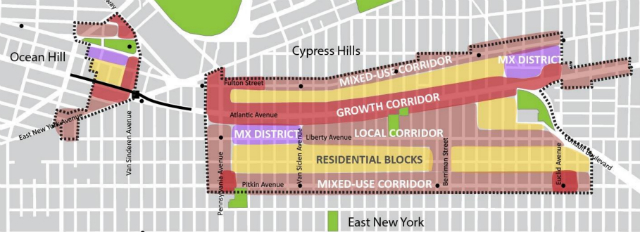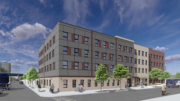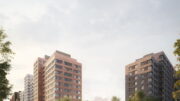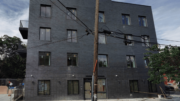On Saturday, the heads of a vast swath of agencies met to announce some details of the de Blasio’s administration first rezoning, in the Brooklyn neighborhood of East New York. Beyond rezoning and encouraging new construction – largely not market-rate – officials spoke about their plans to bring small existing residential buildings out of the market-rate stock and into the world of subsidized, below-market housing, along with a number of other initiatives. The East New York plan will likely be a model for how the de Blasio administration deals with land use and housing in the Bronx, southeastern Queens, and other demographically similar neighborhoods in the city.
On a map, the rezoning will look much like something drawn up by Amanda Burden’s team – the low-density industrial, commercial, and residential zones along major avenues are being upzoned, and the side streets will be “contextualized,” or preserved more or less as-is. Atlantic Avenue would be getting R8A zoning (mid-rise blocks up to a dozen stories), Fulton and Liberty are getting R6A (tenement-scale density), Pitkin and Ocean Hill are getting R7A (somewhere in between). On the other side of Broadway Junction, a dozen or so blocks in the Ocean Hill/Brownsville wedge between Broadway and East New York Avenue will be rezoned for a combination of the above.
The rezoning is, at least in the short-term, entirely about creating subsidized housing, and there will likely be little if any market-rate housing created. The details of mandatory inclusionary zoning have yet to be worked out – what percentage can be market-rate, and what incomes the below-market portion must target – but, for the next few years at least, the prospects of anyone seeing enough demand to do something like an 80/20 project seem slim.
While there is enough demand for market-rate new construction in the neighborhood, for now, rents are only high enough to warrant two- and three-family homes – built widely throughout the 2000s – and perhaps small masonry buildings with a few more units. Large steel-frame buildings with parking garages and long development timeframes are required for an 80/20 project, and so far, rents do not support that.
While the administration will not be encouraging the construction of any more small buildings, they will be working to regulate the rents of the existing small-scale building stock, which dominates East New York. De Blasio’s 10-year housing plan involves the preservation of 120,000 existing affordable housing units (or about 96,000 if you adjust for the fact that it’s a 10-year plan for an eight-year mayor, if he’s lucky), but with the low-hanging fruit of big Mitchell-Lama buildings already picked, the de Blasio administration’s affordability preservation initiative is thinking smaller.
Rent stabilization kicks in at six units, with 55 percent of East New York’s homes left unregulated, according to the administration – a number they’ll trying to bring down. The administration is currently working on a plan to float “direct subsidies, low-cost loans, federal tax credits, and property tax exemptions for apartment buildings in need of repair, energy retrofits, or in financial distress” as possible carrots to be dangled in front of property owners who would give up their unchecked power to raise rents. (In East New York and elsewhere, it’s not clear the de Blasio administration will ever encourage housing that pays its full property taxes.)
Planners aren’t touching the vast M-zoned lands in the 100-acre East New York Industrial Business Zone just south of Broadway Junction, and the areas to be rezoned have very little actual industry and not a ton of commerce either, despite their designations. The non-residential areas to be rezoned are a mix of non-conforming houses and apartment buildings, auto body shops, and empty lots, with the occasional building supply company or other warehouse sprinkled in.
On Atlantic Avenue, the Department of City Planning is reprising its Fourth Avenue strategy and requiring active ground-floor uses – retail, or, more likely, community facility uses. The Department of Transportation is also reworking the network of roads that meet at and around Broadway Junction, including Atlantic Avenue, which are extremely inhospitable to pedestrians.
The housing plan is focused squarely on government-driven stabilization – both through the expansion of rent regulations and through the construction of affordable housing with set-asides for current residents and an inherent tendency to favor longtime New Yorkers – and if successful, would hold the demographics of the neighborhood in place. This means not only fortifying East New York against traditional gentrification by hipsters and yuppies in the long run, but also slowing a changing immigrant mix.
Right now, the main demographic trend in East New York is repopulation. From 2000 to 2010, the neighborhood grew by more than 10 percent, hitting nearly 92,000 residents. Non-Hispanic black New Yorkers still dominate East New York and its newcomers (the Census, frustratingly, does not differentiate between African-Americans and recent West Indian and African immigrants, obscuring what is potentially the largest ethnic shift), but the neighborhood is also losing Puerto Ricans and gaining Dominicans, South Asians, and Mexicans, among others.
Presumably, it’s the newcomers – dominated by Dominicans, South Asians, and Mexicans – who are paying the neighborhood’s rising market rents, which the administration’s survey pegged at between $1,000 for a studio and $1,950 for a three-bedroom apartment. If their plan works, in addition to staving off full-on gentrification, de Blasio could staunch the flow of existing groups from East New York.
The Bloomberg administration was largely successful with pushing through their re-zonings, and we imagine the de Blasio administration will be as well in East New York. There may be some complaints about the lack of a strong plan for promoting industry, but in the end, we expect it to pass. Key questions now are how soon the market will rise to the point where 80/20 development (or whatever kind of market-rate growth they allow) is viable, and how successfully the administration can bring small, unregulated buildings out of the market-rate economy.
Talk about this topic on the YIMBY Forums
For any questions, comments, or feedback, email [email protected]
Subscribe to YIMBY’s daily e-mail
Follow YIMBYgram for real-time photo updates
Like YIMBY on Facebook
Follow YIMBY’s Twitter for the latest in YIMBYnews





